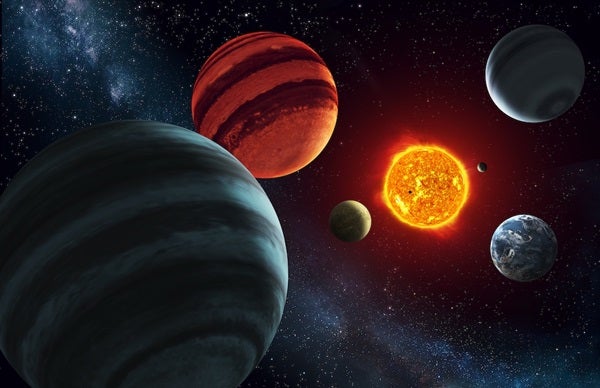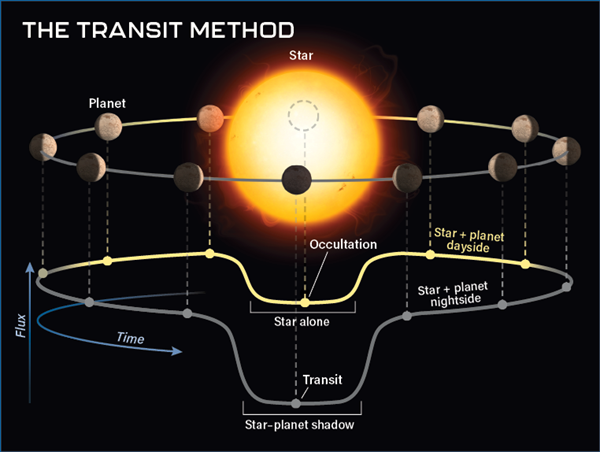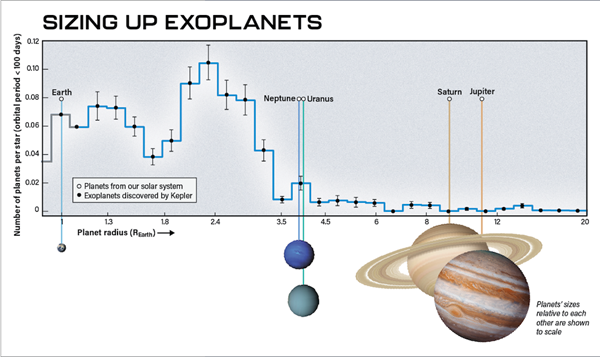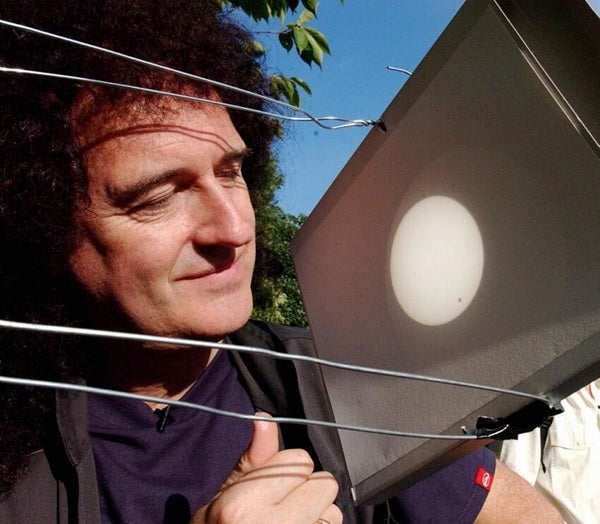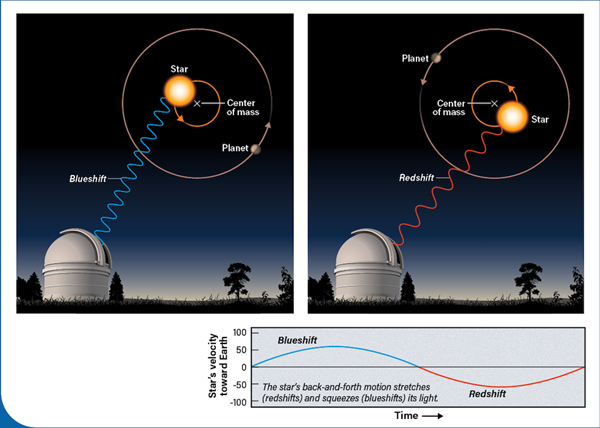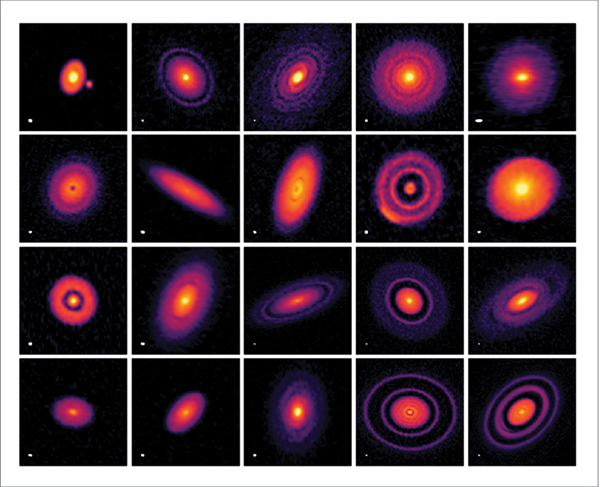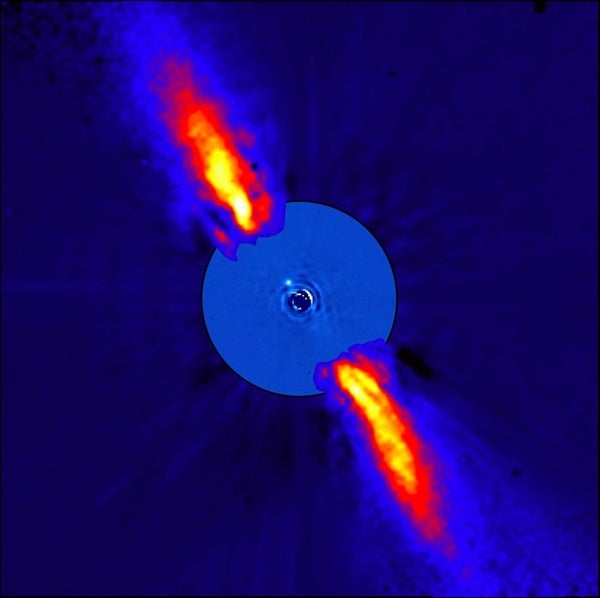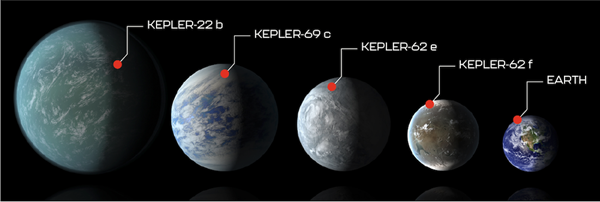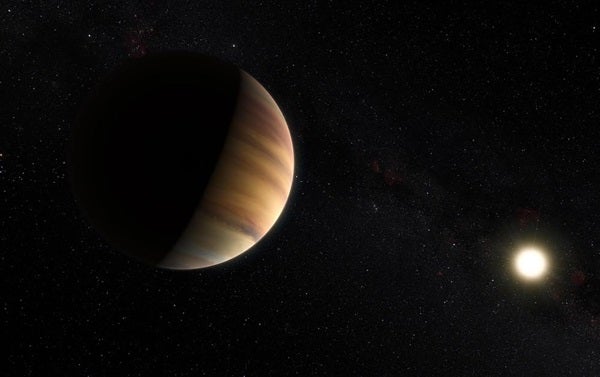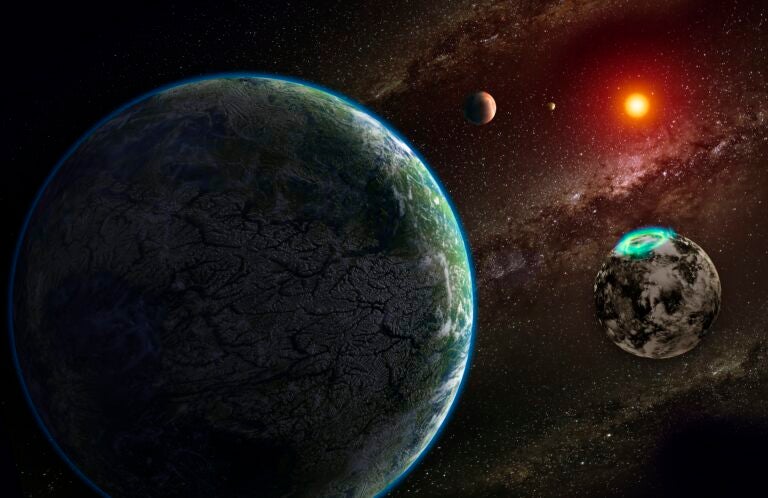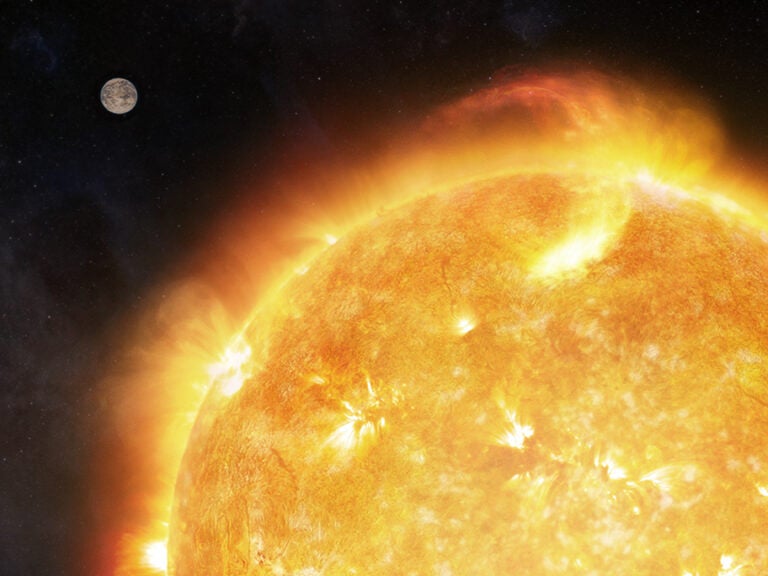While astronomers have been explaining the origin and composition of our Sun’s family of planets for hundreds of years, this story has only come together in the last 30 years or so. Before then, astronomers assumed that planets were born in the location and configuration in which we see them today. The idea of planets moving about while they are forming was only seriously considered once planets in other systems — exoplanets —had actually been found.
The hot Jupiters
In 1995, astronomers studying the nearby star 51 Pegasi found that it appeared to be wobbling back and forth, movement that revealed itself through a regular pattern of Doppler shifts in its spectrum. The observations suggest that the star is in orbit around a position just slightly offset from its center. By measuring the size of the wobble, it was possible to get an estimate of the mass of the perturbing object, which turned out to be less than half the mass of Jupiter, too small to be a star. They had found an exoplanet!
The discovery was puzzling. The new planet completed an orbit every 4.23 days. That placed this giant world, which we would have expected to find in the icy reaches of its outer solar system, seven times closer to its star than Mercury is to the Sun. To find a giant planet so close to its star that its year was measured in just a few days was completely unexpected, calling into question everything we’d assumed about planetary systems.
One such planet might have been an exception, the result of some gloriously unlikely freak accident of planet formation. But “hot Jupiters” like the planet perturbing 51 Peg were found to be common. More than 400 are known to date, and they account for around 10 percent of known exoplanets. This overstates their actual abundance — it is easier to find a large planet close to its star, where it will induce significant wobbles, than to pick out the signal of a puny Earth-sized world. Correcting for these biases, hot Jupiters seem to account for about 1 percent of all worlds. That doesn’t sound like much, but it could easily mean there are a billion hot Jupiters in the Milky Way alone!
Bring the cosmos home
Our universe is a vast, strange place where stunningly powerful phenomena abound. Bang!!: The Complete History of the Universe will take you all the way from the Big Bang that birthed our cosmos through its cold, dark demise in the unimaginably distant future.
Written for everyone with a curiosity about how we got here and where we’re going, this highly anticipated update to a beloved and bestselling book includes more than 20 percent new content. Each chapter dives into a different part of our universal story, exploring the cosmos in depth in an understandable, approachable, and compelling way. This new volume is expanded and retooled to cover the very latest advances in our understanding of every aspect of astronomy, from a clearer picture of the dark matter and dark energy that rule our ultimate fate to the plethora of extrasolar worlds now teaching us in detail how our own solar system — and the life within it — formed.
Penned by rock star and astronomer Brian May, University of Oxford astrophysicist Chris Lintott, planetary scientist Hannah Wakeford, and the beloved late Sir Patrick Moore, this updated edition is sure to become your go-to reference for all things cosmic.
Bang!!: The Complete History of the Universe is now available online at www.MyScienceShop.com.
The method used to find the planet around 51 Pegasi, known as the radial velocity method, requires enough telescope time to pay close attention to a star of interest over many nights. Most exoplanets known today have been found instead by searching for transits, a method which allows us to survey many stars at once. This technique relies on the fact that, if a planet’s orbit happens to be aligned such that — as seen from Earth — it passes in front of the star, the star will appear to fade just slightly. A similar effect is seen from Earth when Mercury or Venus transit in front of the Sun. Thanks to the complexities of planetary geometry, such events are rare, but throughout the galaxy there must be worlds which happen to be positioned such that the planets of our solar system cross in front of the Sun with every orbit, causing a regular series of blinks. Indeed, the nearby dwarf Teegarden’s Star seems to have just such a system. If there are astronomers on these planets, what could they learn about our solar system?
They could measure the radius of each planet relative to the size of the Sun; the amount of light blocked by the planet corresponds to the ratio of the two areas. By timing the period between successive transits, they would get the orbital period and — thanks to Kepler’s laws — the distance of the planet from the star. (You can see why large, close-in planets would be easier to detect via this method than smaller planets which are further from their stars.) Applying these techniques to the known hot Jupiters tells us that they span a range in size that starts from 100 Earth masses (about a third of the mass of Jupiter) and which goes all the way up to 13 times Jupiter’s mass. This higher figure is most likely a fundamental limit; any more massive than this, and the pressure and temperature at the core will be high enough to enable deuterium fusion, at which point the body is at least a brown dwarf and perhaps a full-blown star.
Building giants
This range of masses makes it clear we’re not dealing with planets like our own Mercury, the only world that lies close enough to the Sun to complete an orbit in less than 100 days — a range that includes three-quarters of known exoplanets. How did these strange worlds come to be?
One part of the answer is that it is sometimes easier to form planets efficiently. Perhaps unsurprisingly, there’s a correlation between the metallicity of the star — how much material there is in forms other than hydrogen and helium — and the likelihood that giant planets would exist. The more material there is from which to form planets, the more planets form! But, though this relation sounds like nothing more than common sense, it doesn’t seem to hold for planets smaller than Neptune. This suggests that there is a fundamental threshold that needs to be reached before a giant planet can form.
The necessary conditions must be reached more often in the outer protoplanetary disk, where planet formation can proceed rapidly. To reconcile these hot Jupiters with a theory of planet formation that says that such large worlds must form out beyond the ice line where water and other volatiles exist as ice, the idea of planets migrating through the disk as they form becomes essential. To get to be a hot Jupiter, these worlds must have traveled a significant distance, plowing through the inner disk, gathering up and expelling material through their gravitational pull as they did so. This is probably bad news for any small rocky planets with ambitions to remain in a nice sedate, stable orbit, but it also raises a fundamental question — how do you stop such a planet from falling into the star?
The answer is that most of the time, you probably don’t. In many systems, planets will form, migrate through the disk, and disappear into fiery oblivion. But in some cases, tidal interactions between the migrating planet and its star force the newly hot Jupiter to settle into the circular — stable — orbits we see today.
Tackling the gaps
What of the 99 percent of planets which are not hot Jupiters? The most prolific planet hunter was the Kepler Space Telescope, designed specifically to detect transits. Following launch in 2009, it spent three years staring at a single patch of the night sky, chosen because it is rich in stars and yet devoid of any particularly bright examples, on the border between the constellations of Cygnus and Lyra in the northern part of the sky. Kepler measured the brightness of each of 150,000 stars every 30 minutes, and that of a smaller number of selected systems every minute. Its intended quarry was planets where life like our own might, perhaps, exist — terrestrial worlds around Sun-like stars, preferably at the right distance from the star that the temperature would allow for liquid water. What it found was much more interesting.
It turns out that the most common type of planet in the Milky Way is one that does not exist in our own solar system, with a radius between that of Earth and that of a planet like Neptune, four times larger than Earth. Members of this new class of planets are known as super-Earths, if their density suggests that they are rocky, or mini-Neptunes, if a lower density indicates a gaseous nature. Ideally, we’d know not only the radius, which can be determined by the transit method, but also the mass, for which we need a detection via radial velocity.
Unfortunately, most of the stars studied by Kepler are too far away or too faint to enable useful radial velocity measurements to be made. A new NASA satellite, TESS (short for Transiting Exoplanet Survey Satellite), is searching for planets around nearby stars, partly to correct this problem. So far, what we know is that mini-Neptunes and super-Earths are both so common that it is odd that neither exists in our own planetary family. If we take all the planets found by Kepler on orbits less than 100 days and adjust for the fact that larger, close-in planets are easier to see, over half of the detected planets still fall into this category.
Actually, this exercise reveals another new truth about the planetary population. There’s a distinct absence of planets with sizes right in the middle of the gap between Earth and Neptune; at 1.7 Earth radii, in particular, there are few planets, a feature that has become known as the radius valley. It seems that planets really are either a super-Earth or a mini- Neptune, lying on one side of the valley or the other. The explanation comes from the time when planets are still forming. As the star heats the disk, only the most massive planets can hang onto their atmospheres. If the forming planet is not massive enough, its atmosphere is lost and it will end up as a super-Earth, while the more massive worlds can hang onto the gas and remain mini-Neptunes.
The details of these processes, and how they might have influenced our own world’s formation, are still being worked out, but the existence of this fundamental division between planetary types which we were completely oblivious to until a few years ago gives you an idea as to how fast things are changing. Careful observations of planets on both sides of the radius valley, along with their stars, will be a big part of astrophysics in the next decade or so.
On the move
A third big surprise from our exoplanet discoveries is that one-third of known worlds have orbits which are distinctly eccentric. It’s true that Earth’s orbit isn’t precisely a circle, but it’s pretty close — its eccentricity is 0.016, so the difference in length between the longest and shortest axes is not much more than 1 percent. A third of exoplanets have eccentricities greater than 0.1, an order of magnitude larger. This fact is a clue that life in a forming solar system may be even more complicated than we had suspected until now.
We know that planets can move through the protoplanetary disk, usually by interacting with the material in the disk itself. These large eccentricities were caused by more dramatic interactions between planets — so the fact that the planets of our solar system have largely circular orbits tells us it must have been an unusually calm place when they were forming.
Even more extreme interactions are possible. When two large bodies come close together, their spheres of gravitational influence overlap. Anything caught between them will become dynamically excited — in other words, once-stable orbits will be disrupted, and material can be expelled from the system. It’s even possible for one of the planets to be expelled, spinning off into space.
Some interstellar wanderers have even been detected, thanks to a technique called gravitational lensing, originally developed for looking at distant galaxies. If a planet passes between us and a distant star, it acts as an otherwise undetected lens, bending and amplifying the star’s light and revealing its presence. Distant planets — even on the other side of the Milky Way — can be found by this technique, specifically via a form known as microlensing, because the changes are small. What’s more, the amount the star brightens tells us about the mass of the planet and several of those detected have masses comparable to Earth.
Picture perfect
It’s clear we can learn a lot from these indirect methods of planet detection. Indeed, for most systems we have no choice but to rely on these techniques, where we learn about the planets by studying stars. It is, though, undoubtedly true that direct imaging — seeing the planets themselves — can tell us much more. The problem isn’t so much that the planets are intrinsically faint — especially after formation, when they are still being heated by their gravitational contraction, they will shine brightly — but that the glare of light from the star makes them very difficult to detect.
The solution is to use an instrument called a coronagraph to block the light from the star. By placing an obstruction in the field of view, and through some very careful use of image processing algorithms, planets can be revealed. It is easier to see companions which are further from the star, and direct imaging has been used to find worlds tens or even hundreds of astronomical units from their star. (One astronomical unit is the average Earth-Sun distance.) There are only 50 or so planets which have been directly imaged, each of them extremely precious. They tend to be young, and massive — many are nearly large enough to be stars.
Comparing each of these exoplanet systems to our own raises many questions. Why are the worlds of the solar system on nearly circular orbits? Why don’t we have a super-Earth? Why did Jupiter remain where it was, rather than plowing through the inner solar system and becoming a hot Jupiter? Today, scientists look at the origins of our own solar system in the light of these new discoveries, learning more about our own home now that we’ve looked outward at the stars.

